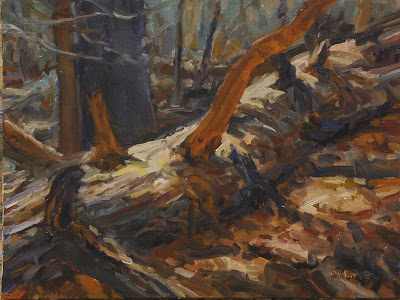Mossy Stump
oil on linen panel 8" x 10"
'The purpose of art is the imaginative transformation of the mind."
Wallace Stevens
If we agree that Wallace Stevens' idea about art is an important and even the best description of what art must be about, we can come to some wondrous conclusions. The first is to understand that all the arts are united in the same task and in ways subtle and obvious, feed off of and nourish each other. The second would have to put an end to any limitation on sources or methods or materials or ideas, other than the qualification they must speak from and to the human condition.
A question that often came up in my classroom was in reference to how we might discern 'good art from bad art' - or better still, 'visually effective art from dull or disinteresting art". That is where the skill sets acquired through motivated practice come in to play. In the visual arts drawing, composition, color, perspective, skilled handling of materials are the primary skills, with drawing above all. Perhaps here is where it all can sometimes run adrift.
Somewhere along the line, (no pun intended), drawing becomes so concerned with its end results it devolves into an imitation of what sits before the artist. A dull accuracy in imitation is what teenagers will often mistake for 'good art', - the more photographic , the better. Instead, drawing as the source headwaters of all visual art forms must be an open-ended investigation. More accurately, drawing must be the nuanced record of one's unknowing investigation of a slice of the visual world.
All preconceived notions and supposed visual experience must be discarded in this sort of drawing - one must approach it as if one had just been given sight by miracle and all the visual world is new and uncertain. Against this uncertainty the artist is armed only with eyes to see and a mark making tool to record with. Its important to understand that all art forms must proceed with the same innocent ignorance and simply use the art form to discover and record the exploration.
The habit of working toward an undetermined end and allowing the journey to become the purpose (instead of a piece of 'art') the artist begins to undergo Steven's 'imaginative transformation' and happily, so does the artist's work. The world is transformed into a seductive, massive chaotic tangle - waiting to be explored and embraced. As soon as one recognizes this effect it becomes addictive - one cannot wait to begin each work anew - to further one's own imaginative transformation in experiencing the visual world. . Another benefit is an renewed ability to better recognize when one's work is getting toward the visually effective and away from the dull and disinterested.


